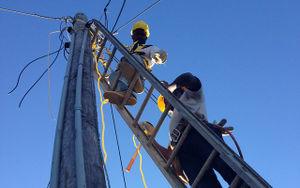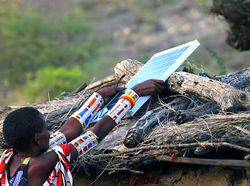Planning energy access: Centralized or decentralized electrification
Background
It has been established that energy access is essential for bringing people out of poverty. Unfortunately, while strides have been made in recent years, it is estimated that around 1.03 billion people around the world do not have access to electricity. In addition, a comparable number of people lack access to modern, safe, sustainable, affordable and regular electricity supply.[1] Electricity supply can be provided by either centralized grid- based means, or by decentralized methods.
There is no one-size-fits all solution to providing energy and each of the available options operates at different scales and serves different specific needs. While there is no universally accepted definition of what the exact scale and capacity of each of these options are, Table 1 gives a general idea of the comparative scale of various decentralized systems.
|
|
Centralized or Grid Electrification |
Decentralized or Off Grid Electrification | ||
|
|
|
Mini Grid |
Micro Grid |
Stand Alone |
|
Scale |
International, National, or Regional |
Community level |
Community level |
Household level |
|
Capacity |
More than 10MW |
Less than 10MW |
Less than 100 kW |
Less than 20kW |
Centralized Electrification or grid extension
This method has provided access to 1.7 billion people from 1990-2010, mostly in urban areas[4]. It is easier to provide electricity access through grid extension in urban areas due to the concentration of people and the generally higher incomes of potential consumers. While an overwhelming majority of the world’s urban population is connected to electricity, the same cannot be said for people living in rural areas. Although some progress in rural areas has been made, significant challenges remain:
- High cost of grid extension: Rural communities have lower population densities than urban areas and have a larger proportion of poor households with lower chances of recovery of investment. Consequently, heavy subsidisation from governments is required.
- Inadequate generation capacity: In many cases, even with infrastructure in place, there was not enough generation capacity to provide a reliable supply.
- Transmission infrastructure issues: Nations may have adequate electricity generation, but poor transmission and distribution planning or infrastructure, as well as issues such as power theft, that negatively impact electricity supply.
- Cost to consumers: Rural areas often have low population density and on average have a poorer population. When charges and fees associated with getting electricity connections are perceived to be high, uptake and use may be limited, thereby negating most socioeconomic benefits that arise from access. This also drives up the average cost for the supplier.
As we can see, electrification through grid extension, especially to rural areas, involves huge investment and risk and is usually taken up by governments, rather than private enterprises. Therefore, for grid-connected access to be effective in providing access to the majority of people, there needs to be sustained commitment and a long term vision from governments to build lasting institutions that plan, regulate, implement and monitor electrification. Electricity also needs to be affordable and dependable for maximum uptake, and thus maximum impact, as providing limited electricity to a limited number of people defeats the purpose of electrification.
Decentralized Electrification or Off-grid electrification
| Decentralized electrification involves generating electricity at or near the place where it will be used. This involves setting up a smaller scale electricity generating unit and supplying to a limited area. These are generally locally managed and supply smaller loads, such as households. They can be integrated to the grid or be completely off-grid. These units can be powered by fossil fuels, such as diesel generators, or by renewables such as solar PV, wind, biomass, micro hydro and so on.[2] |
With falling costs of renewables and improved electricity storage technology, there is an increased interest in decentralized power supplies because, unlike the extension of the centralized electric grid, smaller scale grids can be set up as a viable business using local investment. It can also serve to increase skill levels and employment opportunities in local populations who may be employed in the construction and maintenance of the decentralized systems. For the end consumer, this could provide an option to access energy without excessive upfront costs when services are combined with micropayment or pay-as-you-go models. This would save them the monthly subscription costs as well as the minimum billing amounts often seen in grid connected systems.
However, a decentralized energy supply is not without its challenges.
- High costs and recovery issues: Though costs of renewables are decreasing, the financial expenditure needed to set up a decentralized plant is still high. This would be a problem in poorer regions, if demand is insufficient, or recovery is a problem, since electricity from unsubsidized decentralized systems tends to have high tariffs.
- No subsidies available: The cost problem is increased by the fact that grid electricity is often subsidized either through compensation with highly profitable urban areas (cross-subsidization) or through government funds, while decentralized electricity is often not. This is a basic regulatory issue, connected to the fact that grid companies are well-established and often state-owned, while off-grid power is usually provided by smaller and newer enterprises.
- Skilled manpower: Skilled manpower to manage and maintain these systems may be lacking in remote rural areas.
- Seasonal demand supply mismatch: Seasonal variation of demand and supply needs to be considered in the design of these plants.
- Daily demand supply mismatch: Mismatch between the hourly curves of generation (typically solar) and of uptake (load curve), which implies the need for energy storage provided by batteries.
- Size: As of now mini-systems can only support smaller loads, such as households or limited income generating activities. Scaling up the installed capacity is challenging.
- Environmental risk: the inadequate disposal of storage technologies, such as batteries used in off-grid renewable energy solutions, poses significant environmental risks. Thus, take back systems for such technologies must be considered.
As this is a newer model of electrification, in some countries government policy has not caught up to the latest technology. Some of the issues mentioned herein could be alleviated by the development of appropriate policy measures by governments. This could include easing financing for such projects – such as subsidies, soft loans, rationalizing import duties for panels, formulating tariff guidelines etc., as well as initiating skill development programs and other forms of training to best adapt global best practices to local needs and constraints.
Discussion
Would it be better to continue encouraging decentralized solutions until the grid catches up?
It is important to understand that energy access through both these routes have their own challenges. For instance, the issue of limited generation capacity in decentralized systems is an important one to consider. While this method is currently beneficial for households with low power needs, it may be inadequate when additional power is needed for industry or agriculture. In such scenarios, grid-based access might be needed to transition to efficient electric pumps for better irrigation, which will produce higher farm incomes, or for setting up small-scale industries and other income-generating activities from home that will require more power. In these scenarios, the decentralized systems could be termed inadequate. Thus, these systems are sometimes considered a pre-grid electrification option that is useful for low loads such as home lighting and TV viewing.[5]
It is to be noted that, as income increases due to energy access and implementation of other allied development projects, consumption of energy will also typically increase, requiring further investment in scaling up the decentralized infrastructure. If mechanisms for such scaling up are made easier through policy changes and subsidies, there is a potential for decentralized systems to scale up in installed capacity and distribution ability, thus alleviating a few of the issues mentioned above. Additionally, if current trajectories are maintained in costs and improvements in technological aspects like storage and efficiency, there is opportunity for a rethink in how electricity access paradigms can soon be disrupted.
Before any major disruption, however, it is imperative that policy makers plan for the complementarity of these two routes, making these transitions easier if required in the future. The planning process needs to contemplate the realities on the ground to determine which route to take, considering the proximity of underserved areas to a grid and the challenges posed by terrain and geography. Using technology such as Geographic Information Systems (GIS) mapping to build models which combine geographical information with social and economic data -such as prospective demand, income distribution etc., will help in making informed decisions on which approach is most suitable.
Therefore, in areas where grid extension is considered feasible, such as in the areas that are close to an existing grid, decentralized systems can be considered a temporary measure to provide energy while the long process of grid extension is carried out. However, planners need to account for how the existing systems can be integrated or dismantled once the grid is extended.
Conclusions
One size does not fit all when it comes to electrification, there is no one perfect solution for all scenarios. We can find the most appropriate solution based on local needs, budgets and priorities. Whether a said area is better suited for grid extension or decentralized micro grids, needs to be carefully examined by using technology such as GIS mapping and examining cost implications and local priorities.
Further Information
References
- ↑ International Energy Agency and World Bank, 2017. “Sustainable Energy for All 2017-Progress toward Sustainable Energy.” World Bank, Washington DC.
- ↑ 2.0 2.1 World Bank. (2017). State of electricity access report (SEAR) 2017. World Bank Washington DC Available at: http://documents.worldbank.org/curated/en/364571494517675149/pdf/114841-REVISED-JUNE12-FINAL-SEAR-web-REV-optimized.pdf
- ↑ Alstone, P., Gershenson, D., & Kammen, D. M. (2015). Decentralized energy systems for clean electricity access. Nature Climate Change, 5(4), 305–314. Available at https://doi.org/10.1038/nclimate2512
- ↑ Bazilian, M. 2013. “Towards Universal Energy Access by 2030: Areas requiring further research,” Presentation to the Center for Science and Technology Policy Research, Boulder, CO, February available at http://sciencepolicy.colorado.edu/news/presentations/bazilian.pdf
- ↑ Bhattacharyya, S. C., & Palit, D. (2016). Mini-grid based off-grid electrification to enhance electricity access in developing countries: What policies may be required? Energy Policy, 94, 166–178. Available at https://doi.org/10.1016/j.enpol.2016.04.010
|
This article is part of the Energy Access Portal which is a joint collaboration between energypedia UG and the “World Access to Modern Energy (WAME)". WAME is managed by the Museo Nazionale della Scienza e Tecnologia Leonardo da Vinci (MuST), the Fondazione AEM and the Florence School of Regulation (FSR) and it is supported by Fondazione CARIPLO. |
Written by: Arjun Surendra
























